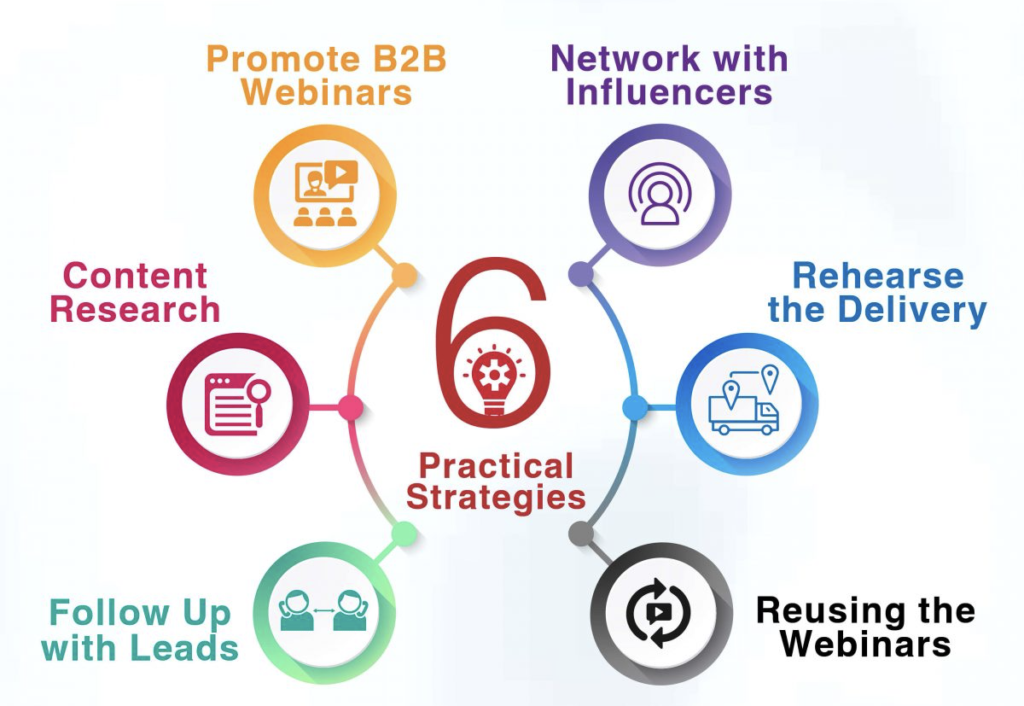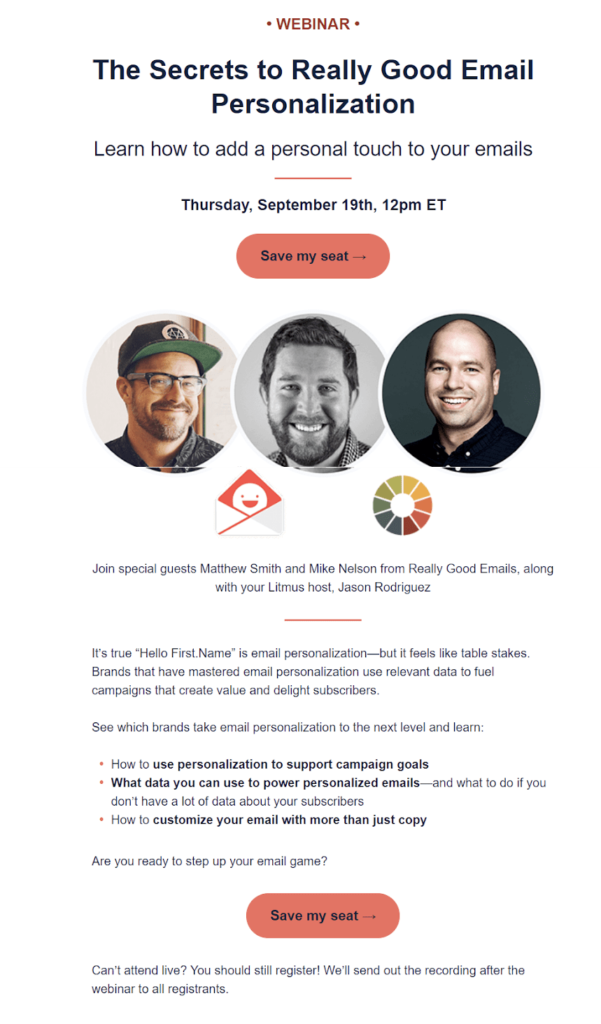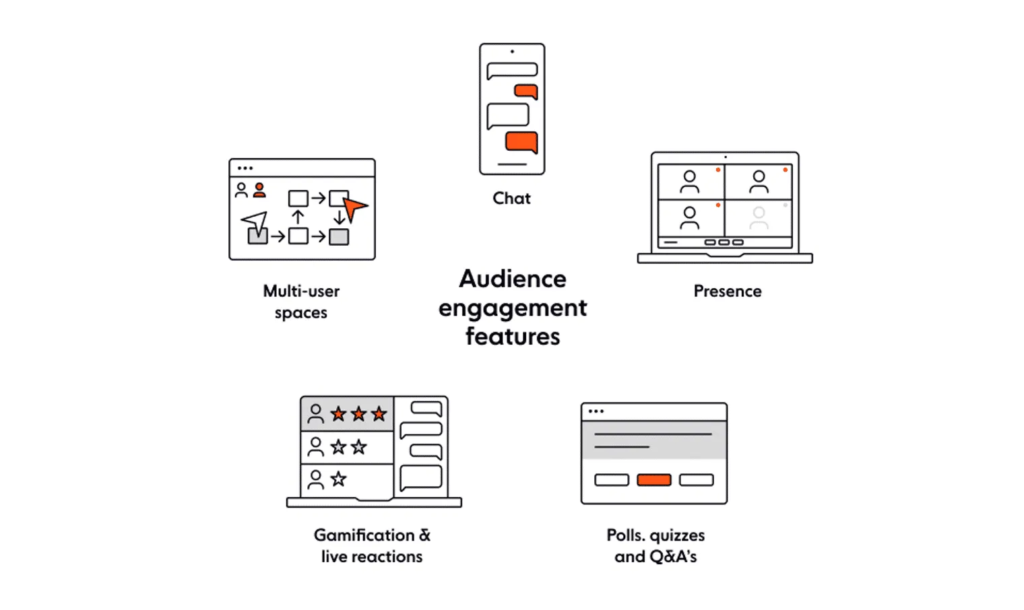8 Tips to Plan and Execute Your Webinar Strategy

Table of Contents
- What is a Webinar?
- Webinar Marketing Strategy
- 8 Key Tips for Better Webinar Planning
- Why Use a Webinar Marketing Strategy For Your Businesses?
As per LinkedIn, 67% of marketers in 2021 increased their investment in webinars. Webinars are an engaging and informative medium for sharing information and can be fun for both the audience and you.
Today, a webinar strategy is considered a key tool for business growth. A webinar marketing strategy provides an interactive experience and is affordable, too. Webinar content marketing strategies have become an integral part of a business to deliver content to customers and audiences and contribute to your content library.
Webinars also build trust and long-term partnerships by boosting brand recognition and sales. A webinar is planned to provide live interactions between a host or speaker and the audience. It is the way to go if you want to reach out to and engage with potential clients.
This blog will discuss all aspects of webinar planning and webinar strategy in detail.
What is a Webinar?

The name webinar is a combination of two words, web and seminar. It literally translates to an online seminar. It is a virtual event that is attended exclusively by an online audience. Furthermore, it is also known as a webcast, web seminar, or online event.
A webinar content strategy needs immense planning and includes presentations, audio, and visual components. During a webinar, the host, speaker, or moderator can interact in real-time with the audience through an instant messaging tool.
To ensure that a webinar is a success, you will need at least one presenter, organizer, and attendees. While the presenter presents and leads the content, the organizer regulates the event flow by working behind the scenes.
Webinar Marketing Strategy

Webinars are not just a medium of learning for school and college students but can also be used to generate leads and stimulate cash flow. A webinar marketing plan builds brand awareness and develops relationships with customers.
Webinars are powerful tools that help marketers promote brand awareness and establish their brand as thought leaders. Webinars also help increase purchases, improve subscriptions, and educate consumers.
The webinar plan should make it engaging, inspirational, and add value with useful information. To ensure that people want more and more webinars from your brand, you should provide a seamless, easy, accessible, and visually pleasing experience. This requires a proper webinar plan and webinar strategy.
Timing is another key factor while organizing a webinar, as you want to ensure maximum attendance. According to Search Engine Journal, Thursdays are the most popular day for webinars. Also, while planning a webinar, it is essential to keep time zones in mind.

8 Key Tips for Better Webinar Planning
Webinar planning is the key to creating, promoting, and campaigning a marketing webinar. Without a webinar project plan, you risk low attendance, unengaged audiences, or both. This complicated process can be made simple with these eight steps for creating a strong webinar plan.
1. Identify your audience
A webinar is a powerful outreach tool. However, the first step to webinar planning is identifying the product or service you want to focus on and identifying your buyers or customers.

As a brand, you may have multiple products, and each product will have a different set of potential buyers. A webinar marketing plan requires you to create a target audience for all your webinar marketing strategies, identify the potential attendees, and then send invites to these potential customers. This marketing journey has five stages: attract, capture, nurture, convert, and expand. Once you have identified the stage to which your target audience belongs, you can create your content accordingly.
Before any webinar planning, it is good to get feedback from the subject-matter experts and even the audience through informal chats, formal interviews, and surveys.
2. Choose a format
The success of your webinar strategy depends on identifying your audience and selecting the correct format that resonates with them. Find out what customers are interested in.

Once you have a topic, you can pick the best-suited format—from interview types, panel discussions, or one speaker webinars. To finalize the format, you can check what your competitors are doing, identify how the webinar will satisfy your business goal, and source a speaker who stands for originality, expertise, and credibility.
Below is a table for your reference on the various formats available.
| DESCRIPTION | PROS | CONS | |
| One Speaker | A single presenter speaks, demonstrates, and answers questions from the audience. | Fewer people to coordinate and train on how to use the webinar tool. | Lack of variety in voices and perspectives. |
| Interview Style | Interviewer asks a set of predetermined questions. | More engaging to hear multiple voices.The fact that the interviewer is asking questions of the expert(s) often encourages the audience to do the same. | More people to schedule, train, and coordinate. |
| Moderated Panel Discussion | Multiple people on the line at the same time, with a moderator facilitating the discussion. | Offers a variety of voices and perspectives | More people to schedule, train, and coordinate.Can be challenging to keep panelists from talking over each other. |
| Interactive | Audience members participate fully via instructor-led exercises and facilitated conversations. | If done well, participants receive a deeper understanding of the topic because they’re fully engaged in the dialogue and the exercises. | Can only accommodate a small groupRequires a very skilled, experienced facilitator |
3. Select a speaker
Once you have finalized the format, it is crucial to pick a speaker who is not only an expert on the topic but also keeps the audience engaged. Thought leaders with higher followers might also be an added advantage for a webinar marketing strategy.
Leveraging experts always makes the audience interested and also pulls in more audience. If your chosen webinar format involves more than one speaker, it is important to have them play off of each other during the discussion. For a webinar to run smoothly, it is advisable to meet all webinar panelists and walk through the webinar topic.
Every webinar must also have an organizer or facilitator apart from the speaker. The speaker should prepare and deliver the presentation to give an engaging experience. The organizer/facilitator works backend, developing the webinar topic, marketing the event, communicating, and setting up the registration.
4. Schedule the webinar and promote
Your webinar strategy’s success depends on the date and time of the webinar. According to statistics, Tuesdays, Wednesdays, or Thursdays are the best days for good turnouts.
While selecting a time, you also need to ensure all the major time zones in your target market are covered. Once you have the audience, format, and schedule, you need to build a webinar promotional plan.

Once you have decided on the target number of attendees, sending an email as a webinar marketing strategy should generate registrations for your event. Ideally, send out information on the webinar two to three weeks before the event. The communication should convey the intended message to the audience. You can also promote the event through other channels, like social media, the company website, local events or newsletters, etc..
5. Create a fantastic slide deck
A key to a good webinar content strategy is to create a visually appealing slide deck. As most webinars run for 30-60 minutes, a good slide template is a game-changer. The branding should be consistent in the slide deck, and the slides should be image-heavy for a professional and engaging result.

Writing long paragraphs on a slide can put your audience to sleep. However, it is also important to stick to one color palette to avoid the slides from looking too busy. Your slides should include comparisons and contrast ideas, summarize key takeaways, share statistics to make them interesting and gripping.
6. Check the audio and video thoroughly
Always test your webinar platform before going live to avoid any last-minute technical problems with the audio and videos. Do a soundcheck to prevent your computer’s muffled sound from preventing people from hearing what is played on your screen.
Poor audio is distracting and can make the audience struggle to hear the speaker. It is also recommended to use an external microphone while presenting.
7. Leverage on social media and use a hashtag
Complementing your webinar content strategy with other forms of media, like screen sharing, social media activities, taking screenshots, and posting them on social media, either during or after the webinar, can make the webinar interactive and engaging. It gives your event a personal touch.

Using a hashtag in your webinar marketing strategy can make it unique. Also, creating a new hashtag will ensure all tweets are about your webinar. A hashtag can be used to reply to any unanswered questions and send additional information.

8. Share the recorded webinar
Post the webinar, upload the recording of the webinar along with audio and chat conversations. You can upload it on your company’s website, social media, or YouTube for maximum reach. You can always add a CTA to the recording to help in conversions. Ensure the recording is shared with all the participants.
Why Use a Webinar Marketing Strategy For Your Businesses?

Now that we have discussed the basics of a webinar, let’s look at why you should invest in a webinar marketing strategy. Below are some advantages of hosting webinars.
1. Builds a content library
Webinars should always be recorded. These webinar clips add to your brand stories when posted on social media. You can also upload the webinar recording to YouTube or the company’s website as part of your webinar content strategy. You can also transcribe the webinars and use snippets in the form of blogs or social media content.

Creating relevant, educational content and presenting the same to your audience regularly acts as a good recall strategy. A good webinar marketing strategy will ensure your customers keep coming back, which will help grow your business in the long term.
With webinars being one of the most robust platforms today, you can reuse all old content multiple times by turning a webinar into a white paper, a blog post, an email, and much more.
2. Creates brand awareness
A recognizable brand that stands out from the competition is one of the pillars of a successful business. A webinar marketing strategy helps you take your brand to more people, creating brand awareness every time you host a new webinar.
Webinars planned well help your business build authority and boost your standing in the market. It creates trust with the target audience and makes them comfortable buying your product and services.

A webinar project, planned with engaging and valuable content, builds brand awareness and makes your target audience lean towards your brand. During webinars, focus on sharing innovative ideas and spreading a meaningful message, as this will bring the audience closer to your brand.
However, prior to a webinar, planning a little audience research and USPs can help build a rock-solid webinar marketing strategy. Webinars help you expand your audience globally without you leaving your chair. It builds brand recognition among a wider audience across the globe.
3. Drives audience engagement
Webinars, by nature, provide an engaging experience. Hence, incorporating a webinar strategy in your marketing plans stimulates the audience’s attention. A webinar is an ideal platform to help you engage with your audience in real-time, a benefit rarely offered by other marketing channels.
One can never compare interacting face-to-face during a webinar to responding to social media posts. With a webinar, it is almost as if the audience and host are all in the same room with a webinar.

A well-planned webinar marketing strategy leads to better engagement with the audience, resulting in better relationships and greater customer loyalty. In fact, webinars can include question and answer sessions, chat, live polls, and immediate audience feedback. It helps measure attendees’ behavior and understand their buying interests through their engagement.
4. Generates leads
As soon a customer registers for a webinar, they show a clear interest, thus qualifying them as leads. Webinars help proactively link sales leads to the next stage of the buyer’s journey through a website, a sales rep, or another piece of content.

A webinar on your product/service, insight on a current trend, or your solution to recurring industry problems builds your credibility and helps influence your potential customers. Through webinars, not only can you advise your audience on the information they need to buy your product, but you can also establish your position as a market leader.
In Summary
Webinars are powerful tools for business, be it for lead generation, sales, or training. A key factor in making a webinar worth attending for an audience is it being informative and engaging.
The audience should enjoy the content to continue attending future webinars. Webinar planning and webinar strategy execution do take a lot of time, but the benefits you reap from it are just worth it for your business. Hopefully, this article has inspired you with the potential benefits of webinars.
Key Takeaways
- Set the right expectations and pick an optimal date and time.
- Webinar marketing strategies not only generate leads but also bring in conversions.
- Add a catchy webinar title that also tells the audience about the topic.
- Make the webinar interactive, with real-time chats.
- Record your webinar for future reference and recall for the attendees.
- Webinars can educate about products or services, engage about an organization’s plan, or teach new relevant topics.
- Webinars can be attended by anybody in any geographical location.
FAQs
A good webinar should include an impactful introduction, a brief outline of the presentation, an interaction session, and a relevant call to action.
To improve your webinar, be energetic and share firsthand experiences, engage with the audience, create engaging slides, understand the audience’s expectations, and deliver accordingly.
For a 60-minute presentation, about 30-40 slides is a good number. This should also leave a lot of scope for interactions.
After welcoming the attendees, briefly introduce the topic, and set expectations. Also, inform the audience if the recording will be available later.
To organize a webinar and generate leads from the same for your business, decide on a webinar topic, choose a format, create content, select a schedule, promote, and finally, run the webinar.
It is said preparation is the key to any success. For a good webinar, prepare a script and practice the same. This dry run or trail run helps the speakers and host.
Latest Blogs
Learn how to rank on AI search engines like ChatGPT, Perplexity, and Gemini by optimizing your content for authority, structure, and relevance. Stay ahead in AI-driven search with this strategic guide.
Explore the best healthcare SEO services for your medical practice. Improve online visibility and effectively reach more patients in need of your services.
Discover top social media agencies specializing in banking solutions, enhancing financial services and driving engagement.
Get your hands on the latest news!
Similar Posts

Content Marketing
4 mins read
11 Best B2B Content Marketing Agencies for B2B Companies in 2024

Content Marketing
5 mins read
Top ecommerce Marketing Agencies with Proven Strategies for 2024

Content Marketing
5 mins read